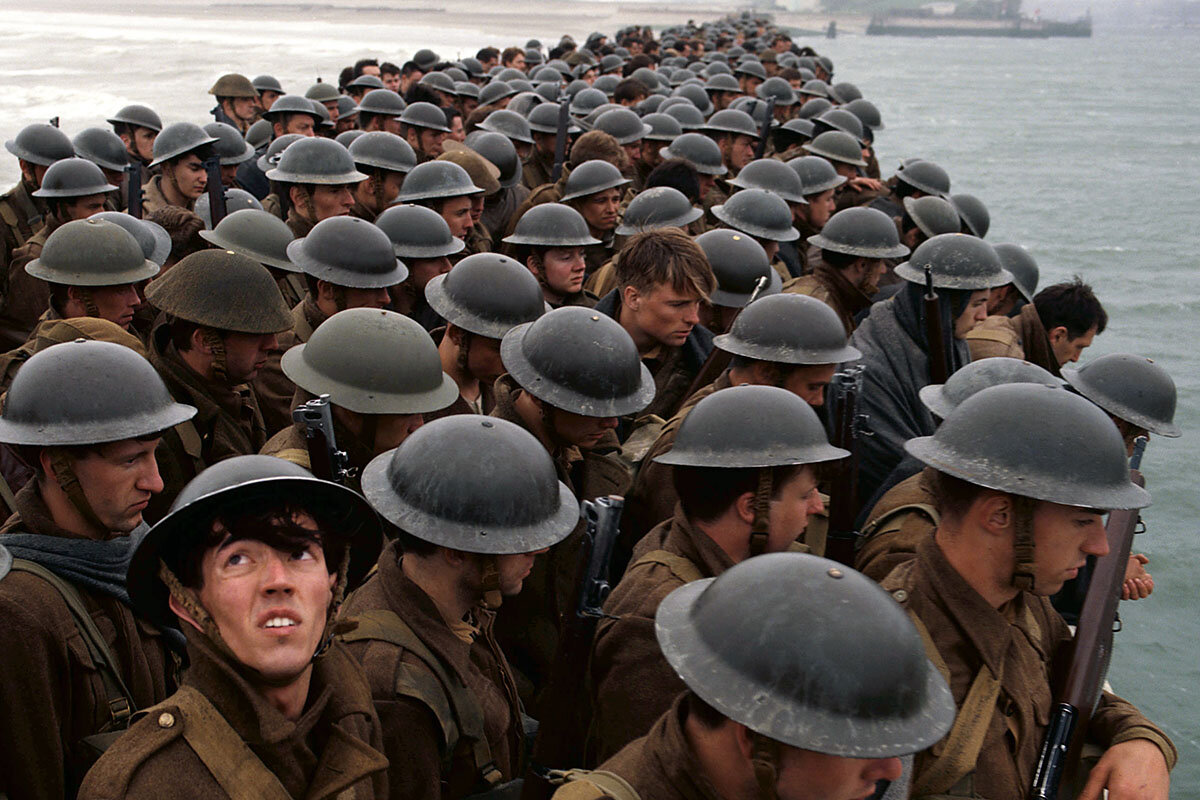Christopher Nolan started out making enigmatic little indie films but quickly found his calling with the pitch-black “Dark Knight” trilogy and such grand-scale metaphysical behemoths as “Inception” and “Interstellar.” (Nolan never met a black hole he didn’t like.) And so his latest film, “Dunkirk,” comes as something of a surprise. With a brisk running time of 106 minutes, it’s about the rescue of Allied troops from the beaches of Dunkirk in northern France beginning in May of 1940 after they were hemmed in by German enemy fire. Except for its scale and tricky narrative structure, it’s almost nothing like his other movies.
It’s also not much like other war movies. Nolan, who both wrote and directed, has stripped away most of the usual genre clichés and focused instead, with highly variable results, on the minute-to-minute struggles for survival.
The action, segmented into episodes variously drawn from a day, a week, and an hour of the battle, is registered primarily through the experiences of Tommy (Fionn Whitehead), a raw recruit who teams up with two other soldiers (played by Aneurin Barnard and pop star Harry Styles) to flee the beach; a civilian sailor, Mr. Dawson (Mark Rylance), and his teenage son, Peter (Tom Glynn-Carney); and a Royal Air Force ace, played by Tom Hardy, who, as in Nolan’s “The Dark Knight Rises,” is once again masked for virtually the entire movie. (Is it too late for him to play the Phantom of the Opera?)
Nolan filmed mostly in IMAX and 65mm, and from the first scene, with Tommy fleeing on foot from German fire, the experience is totally immersive. (It’s like 3-D but without the glasses.) The visuals may be scaled big, but the narrative is very much human-sized – except that Nolan doesn’t provide much back story for anybody. We know that Tommy is green and very scared; Dawson is low-key and stalwart; the aviator is relentless. We don’t learn about their families, their sweethearts, their politics, their prejudices. These people have a generic gloss, as if they were stand-ins for all the others like them.
Nolan intends this lack of specificity to scour the film of cant and cliché, but in some ways, it has the opposite effect: We can’t help but see these protagonists as the iconic standard-bearers of the famous “Dunkirk Spirit.” It was that spirit, on full display here, that probably saved England from capitulation to Germany. The military disaster that was Dunkirk has been mythologized, rightly so, as a triumph: The shallow waters made it impossible for British destroyers to land on the beach, so hundreds of private small boat owners across the English Channel came to the rescue, in constant danger from Luftwaffe bombardments. The military was hoping to evacuate around 40,000 troops. The final total was more than 338,000.
The fact that the Dunkirk saga, momentous as it is, remains relatively unknown to movie audiences outside England gives the film a cachet. But Nolan isn’t interested in the dynamics of the battle itself. There are few scenes with officers plotting strategy, no discussion of Hitler’s decision, still debated among historians, to purposely withhold the final blow to the Allied forces. Amazingly, there’s very little blood, and we never even see the enemy up close.
What Nolan may not recognize is that all those war movie clichés he disdains about family and sweethearts and the life back home actually contribute to why we care about the warriors. I’m not arguing for a lot of corn in “Dunkirk,” but maybe just a little bit?
Nolan has never been a deep diver into the human psyche, and it’s possible that his antipathy for the usual war movie tropes is based on nothing more than his inability to pull them off. When he does make the attempt, as in the scenes with the boat skipper, or with Kenneth Branagh as a naval commander tearing up at thoughts of “home,” the results are as bland as in any conventional war movie.
“Dunkirk,” with its scaled-to-be-a-masterpiece visual grandiosity, aims to be an epic of the spirit, but there is something weirdly underpowered about it. It’s a series of riveting tableaux, but the human center is lacking. When “Dunkirk” was over, I felt as if I had been through something, but it wasn’t a war, exactly. For all its painstaking realism, the movie resembles a great big impressionist abstraction. Maybe it’s not so different from Nolan’s other movies after all. Grade: B- (Rated PG-13 for intense war experience and some language.)





